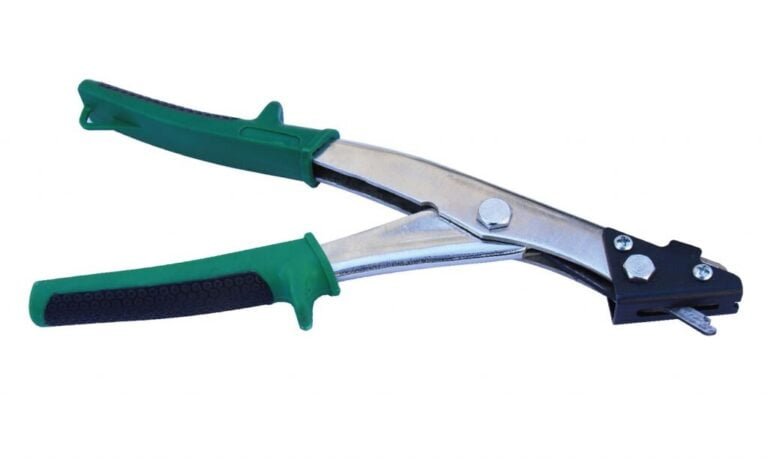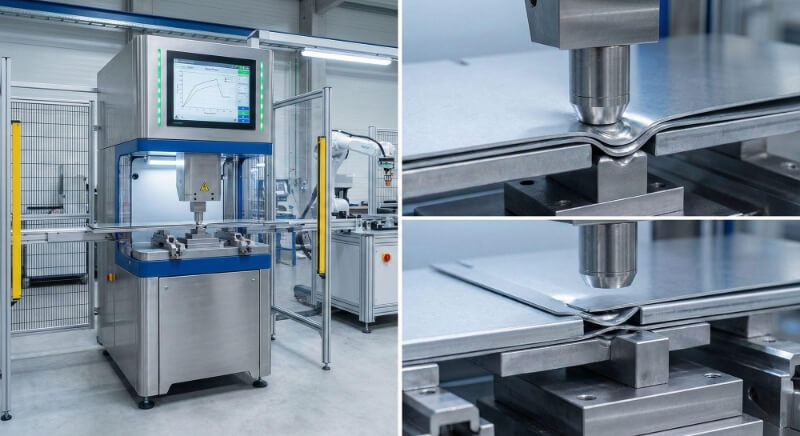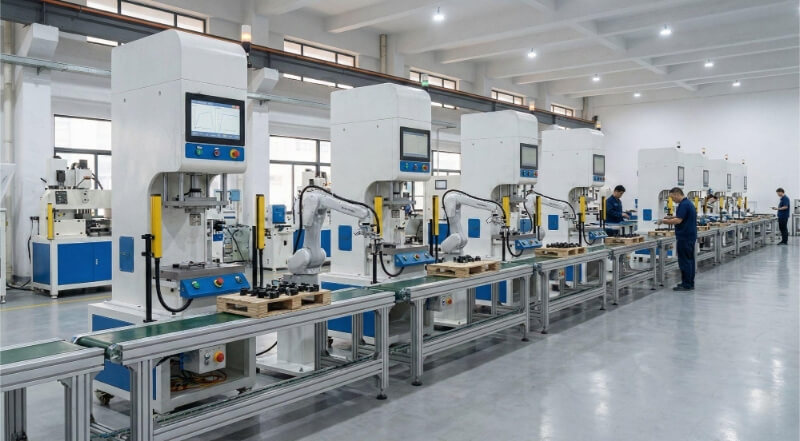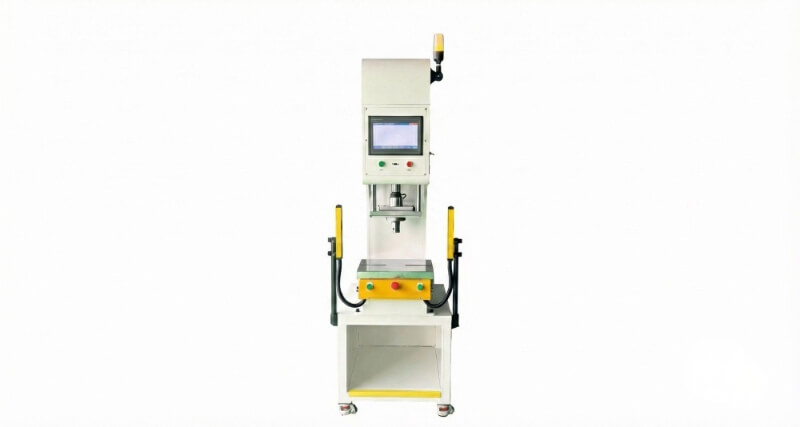Many people new to sheet metal work struggle with how to cut complex shapes without using expensive tools. That frustration grows when laser cutting seems overkill and punching can’t handle tight curves. Nibbling offers a surprisingly simple, flexible solution. It’s beneficial for prototypes, one-offs, and custom jobs that don’t justify the cost of full dies. If you’ve felt limited by cutting options, this might be the method you’ve been missing.
This method sounds basic, but its ability to work with complex shapes and tight budgets makes it valuable in many workshops.
What Is Nibbling in Sheet Metal?
Nibbling is a cutting process used in sheet metal work. It uses a punch and die set to remove small, repeated sections of material. This happens one step at a time.
The tool moves across the workpiece in short strokes. Each punch makes a small hole or notch. These holes overlap. Together, they create a cut that follows any path.
Nibbling machines can be manual or CNC-controlled. Manual nibblers are suitable for hand-guided work. CNC nibblers utilize preset paths to achieve cleaner, more accurate results.
This process works on many sheet metals. Steel, aluminum, and stainless steel are common choices. The metal thickness usually stays within a workable range—often under 6mm.
It’s ideal for tight curves, internal cutouts, and small-batch parts. Since there is no need for custom dies, it saves money in short production runs.
Essential Tools and Equipment for Nibbling
To use nibbling effectively, you need the right equipment. The machine, tooling, and support tools all play a crucial role in determining the effectiveness of the process. Below are the core items used in most setups.
Types of Nibbling Machines
There are two main types of nibbling machines: manual and CNC-controlled.
Manual nibblers are often handheld or bench-mounted. They are suitable for low-volume jobs or basic shaping tasks. The operator guides the machine by hand, which makes it more flexible but less precise.
CNC nibblers are automated. They follow a digital design to move the sheet and punch in a specific path. These are better for accuracy and consistency in higher-volume work.
Some turret punch machines also have nibbling functions built in. This adds versatility without needing separate equipment.
Nibbling Machines Components
A nibbling machine has several key parts:
- The punch is the moving part that strikes the metal. It pushes small pieces through the die, which is the fixed part below the sheet. The die supports the metal and controls the shape of the cut.
- The worktable holds the metal flat. Some tables are adjustable to support large or heavy sheets.
- The motor or pneumatic system powers the punch. In CNC systems, a controller guides the punch path using G-code.
Additional Tools for Precision Work
Some extra tools help improve the final result:
- A deburring tool removes sharp edges left by the punch. This keeps the part safe to handle and improves appearance.
- Sheet clamps keep the material from shifting during cutting. This helps accuracy.
- Templates or guides can help in manual nibbling, making it easier to follow curves or repeat shapes.

Step-by-Step Guide to Nibbling Sheet Metal
Nibbling sheet metal is easy if you follow clear, step-by-step instructions. Here’s how to prepare, set up, cut, and finish your work effectively.
Preparing the Sheet Metal
Start by choosing the right thickness and type of metal sheet. Check if the metal is flat and clean. Remove dirt, oil, or rust, which can affect your cut.
Next, use a marker or scribe to outline your cutting path clearly. Make the lines easy to see. Secure the metal firmly to prevent slipping during cutting.
Setting Up the Nibbler
Check your nibbling tool carefully. Make sure the punch and die are clean and sharp. Adjust them if needed. Lubricate moving parts lightly to keep the tool working smoothly.
Set your machine’s speed and stroke depth according to your metal thickness and the shape you’re cutting. Adjust the guides or fences to help you follow the marked lines accurately.
Executing the Cut
Hold the nibbler firmly. Begin cutting from one edge of the sheet, carefully following your marked line. Keep the tool steady. Move slowly but consistently along your path.
Maintain gentle pressure and don’t force the tool. Let the punch action do the cutting. Stop occasionally to remove metal chips and check your progress.
Finishing and Deburring
After cutting, your edges will be rough and sharp. Use a deburring tool, flat file, or rotary grinder to smooth these edges. Work carefully along the entire length of the cut to remove sharp or uneven spots.
Advantages of Nibbling in Sheet Metal Work
Nibbling offers several benefits that make it a wise choice for specific metalworking tasks. It’s beneficial when working with custom shapes or small batches.
High Flexibility for Irregular Cuts
Nibbling shines when cutting curves, notches, or complex outlines. You can change direction easily during the cut. This flexibility is ideal for making prototypes or low-volume parts without needing custom dies.
Versatility in Material Thickness
Nibblers work on a wide range of metal thicknesses. Handheld nibblers typically handle thin sheets, such as aluminum or mild steel. Heavy-duty models can cut thicker materials, including stainless steel.
Minimal Waste and Cost Efficiency
Nibbling removes only small pieces of metal at a time. This keeps material waste low. You don’t need large tools or expensive dies, which saves on setup costs.

Limitations and Challenges of Nibbling
While nibbling is helpful in many cases, it also comes with a few downsides. It’s beneficial to be aware of these limits before selecting this method.
Material Restrictions
Nibbling works best on soft to medium-hard metals. Tough materials can wear down the punch and die quickly. Some metals, such as thick stainless steel, maybe too tough for light-duty nibblers.
Potential for Rough Edges
Nibbling cuts by punching small overlapping holes. This leaves a jagged edge. The more curves or tight turns you cut, the rougher the edge can get.
Noise and Vibration Concerns
Nibbling can be noisy. The repeated punching makes a loud tapping sound, especially on harder metals. Long cuts or thick sheets can cause the tool to shake. This may affect accuracy or cause fatigue if used manually for an extended period.
Tips for Effective Nibbling
Getting good results with nibbling depends on how you handle the tool and the setup. Here are some tips to help improve accuracy and safety.
Use the Right Punch Size
Select a punch size that suits your cutting requirements. Smaller punches create smoother curves and tighter corners. Larger punches work faster but may leave rougher edges.
Make sure the punch and die match well. A mismatch can lead to poor cuts or damage to the tool.
Secure the Sheet
Always clamp the sheet metal in place before cutting. Movement during nibbling can cause misalignment, jagged cuts, or tool jams.
Use a firm, flat work surface. If the sheet bends or vibrates, your cuts will be less accurate.
Control Speed
Move at a steady pace. Going too fast can make the tool skip or drift off the line. Going too slow may overheat the tool or distort the metal.
Monitor your stroke rate if your machine allows it. Slower speeds give more control for tight shapes. Higher speeds help when cutting straight lines.
Common Applications of Nibbling
Nibbling is used in many industries. It’s a go-to process when flexibility, speed, and simple setup are more important than a polished finish.
HVAC Ducting and Electrical Cabinets
Nibbling is often used to cut vents, holes, and access panels in HVAC ducts. It allows quick changes to duct sizes or shapes without the need for custom tools. In electrical cabinets, it helps create openings for switches, cable paths, and connectors.
Automotive Body Panels and Chassis
In the auto industry, nibbling helps trim or modify metal sheets used in bodywork or chassis design. It’s ideal for custom shops or small repair tasks that require tight curves or rapid changes. Shops use it to make cutouts for lights, mounts, or custom design features.
Prototyping and Low-Volume Custom Parts
Prototyping often involves one-off parts or quick revisions. Nibbling handles these tasks without waiting for special dies. Startups or small manufacturers use it to produce small batches. It saves time and money while offering design flexibility.
Comparing Nibbling to Other Cutting Techniques
Nibbling isn’t the only way to cut sheet metal. But depending on the job, it may be the better choice. Here’s how it compares to other methods.
| Feature | Nibbling | Shearing | Laser Cutting |
|---|---|---|---|
| Cutting Style | Repeated punching | Straight blade shearing | High-powered laser beam |
| Best For | Irregular shapes, curves | Straight cuts, simple shapes | Detailed, clean cuts |
| Edge Finish | Rough, needs deburring | Clean, straight edges | Very smooth |
| Material Thickness | Thin to medium | Thin to thick | Thin to medium |
| Setup Cost | Low | Low to medium | High |
| Speed (Complex Cuts) | Medium | Fast (only straight lines) | Fast |
| Tool Cost | Low | Medium | High |
| Heat Affected Zone | None | None | Minor |
| Design Flexibility | High | Low | High |
Conclusion
Nibbling is a practical and flexible method for cutting sheet metal, especially for irregular shapes and small production runs. It works on different materials, requires simple tools, and doesn’t need expensive dies. For engineers, designers, and manufacturers, nibbling offers a solid balance between precision, speed, and budget.
Need help with custom sheet metal parts or low-volume cutting work? Contact our team to get expert support and a fast quote tailored to your project.
Hey, I'm Kevin Lee

For the past 10 years, I’ve been immersed in various forms of sheet metal fabrication, sharing cool insights here from my experiences across diverse workshops.
Get in touch

Kevin Lee
I have over ten years of professional experience in sheet metal fabrication, specializing in laser cutting, bending, welding, and surface treatment techniques. As the Technical Director at Shengen, I am committed to solving complex manufacturing challenges and driving innovation and quality in each project.




